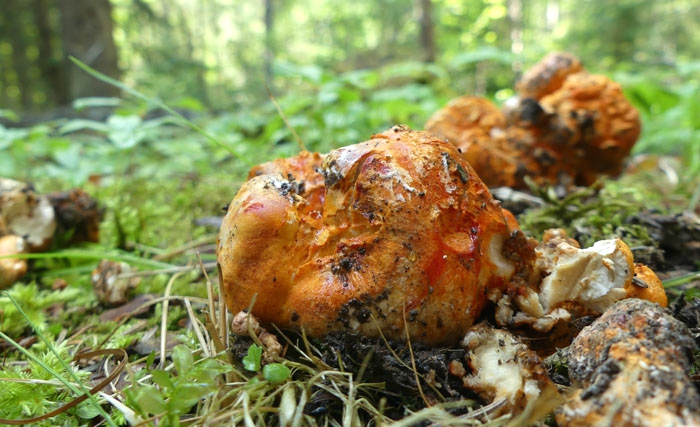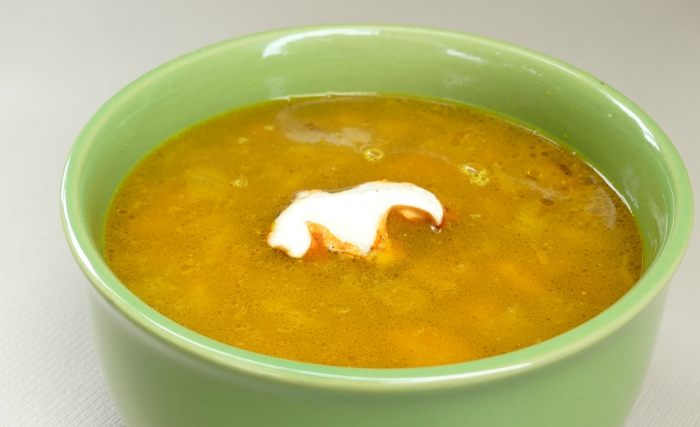Lobster mushrooms have a distinctive taste that some describe as being lobster-like; however, most people claim the wonderful aroma and taste is more nut-like. This edible fungus is called the lobster mushroom because of its appearance being similar to a lobster: dark orange on the outside with white inside, not because of its taste. Lobsters are a choice edible mushroom that is delicious and meaty.
Lobster Mushroom Growth
The dark orange exterior of this mushroom is the stromatic sterile tissue of the ascomycete (Hypomyces), and the white flesh on the inside is the flesh of a basidiomycete mushroom; usually a Russula. In a funny way this fungi can be considered being the result of mycological cannibalism.
The parasitic fungus Hypomyces lactifluorum infects and colonizes the non-edible mushroom Russula brevipes transforming it into the lobster mushroom. It can also infect the acrid-tasting Lactarius piperatus.
In a pioneering study in Botany, Genevieve Laperriere and colleagues from the University of Quebec tracked the infection process and colonization of Russula brevipes by the parasitic fungus Hypomyces lactifluorum. Laperriere and his team extracted DNA from infected (edible) and non-infected (non-edible) mushrooms collected from various sites around Quebec. They found that the infected and edible lobster mushroom mostly contains the DNA of the parasitic fungus with only trace amounts of Russula brevipes DNA.
Laperriere and his team also measured intermediate products of chemical reactions, or metabolites, in infected and non-infected mushrooms. Metabolites help determine how fungi look and taste, and whether they are fit to eat. They found that through the course of its infection, the parasitic fungus completely alters the diversity and amount of metabolites in Russula brevipes.
Their work discovered that terpenes, small chemical products synthesized by Russula brevipes, are completely absent from lobster mushrooms infected by the parasitic fungus. Russula brevipes produces these chemicals partly for its protection and defense against infection. The complete absence of terpenes from lobster mushrooms indicates a successful infection by the parasitic fungus. Some varieties of terpenes are responsible for the pungent taste of Russula brevipes. Laperriere and his team speculate that during the course of infection, these chemicals get converted into other more flavourful compounds, making lobster mushrooms palatable.
Lobster Mushroom Benefits
Lobsters are an excellent source of Vitamin D. Almost two cups of lobster mushrooms contain 160 calories, 32% of the RDA of iron, 16% of the RDA of calcium, 8% of the RDA of dietary fiber, and 4% of the RDA of protein. Lobster mushrooms also supply a powerful mix of vitamins A, B-complex and C, which helps to boost and support the immune system.
Lobster mushrooms are rich in ergothioneine, (an amino acid), which is a strong antioxidant that provides protection from the action of free radicals that can mutate cells, while improving the reaction of the immune system. Ergothioneine has sulfur in its structure. Despite sulphur being a common element, many people have a deficiency of sulfur. (Sulfur is the eighth most common element by mass in the human body, behind oxygen, carbon, hydrogen, nitrogen, calcium, phosphorus and potassium.) This antioxidant compound is only found in mushrooms and provides a significant boost to the immune system.
Natural antibiotics with a similar structure to penicillin are found in all types of mushrooms. They stop the growth of germs and can also defeat fungal infections. Most of these compounds are beta-glucans and polysaccharides that also provide an immune system boost, as well as cure ulcerous wounds or ulcers and healing their infections.
Harvesting Lobster Mushrooms
Lobster mushroom can be harvested mid-summer to early autumn depending on location. They are typically found in forests with oaks, poplars and other deciduous trees. If you find lobster mushrooms in one area, they will appear in the same location the following year.
Cloth bags are best to use while gathering. Always carry a soft bristle brush (or new toothbrush); this is very useful to clean the dirt from the mushrooms. Cut them as low along the stem as you can, but try not to just pull them from the ground. The mycelium that connects them to the soil should be left undisturbed. Keep in mind that washing mushrooms will make them absorb water, which makes them soggy. Lobsters are best cooked after being cut into small pieces.
Lobster Mushroom Soup
There are many lobster mushroom recipes on the Internet. If you want to make a healthy lobster mushroom soup that takes very little time, be sure to check out my recipe by clicking here.
Warning
As with other fungi, be sure that what you harvest is the lobster mushroom! Never consume any edible wild mushroom raw – always cook first!
Sources:
NRC Research
Weston Price
Herbs 2000
Further Reading:






I have a dependable spot for lobsters but I’ve always been disappointed with the flavor (or lack thereof). After reading your article, I think I’ll try again, because my disappointment stems from the fact that while they smell (to me) strongly of shellfish, they do NOT taste that way! Maybe if I adjust my expectations away from lobster and toward mushroom, I’ll be pleasantly surprised!
I have never been able to relate to the “tastes like XXX” when it comes to mushrooms (with one exception — Bears Head Tooth really does taste and have the texture of sweet crab!), so I totally relate. Yeah, lobsters taste like… mushroom… to me too. They have a very distinct texture — so firm and dense, so I look at them that way when figuring out what to do with them.
Why cook first ?
Uncooked wild mushrooms tend to be poorly broken down in digestion, therefore depriving the body of their nutritional contents. More importantly, many varieties of wild mushrooms are disagreeable when eaten raw because they can cause severe digestion troubles, not to mention many wild mushrooms have viscid surfaces (although not lobsters).
Karen, I have a mood spore and fungus allergy manifested by intestinal anaphylaxis. Would cooking mushrooms kill off the mood spores and fungus making them safely digestible?
Yes and no – – depends on many factors but to be on the safe side just avoid eating any mushrooms!
What’s up, always i used to check web site posts here
in the early hours in the daylight, for the reason that i enjoy
to learn more and more.
Does this look like a lobster mushroom? It has a smooth surface on bottom side .
Your website is the best. Love it! Love your style. This is the best website about wild food and please always keep it going! Lobsters are yummy and thanks to you I am really enjoying these.
Thank you Owen – your kind words are appreciated!
Question… how long does it take russula to turn into a lobster after the fungus latches on?
That is an interesting question I have not been able to find an answer to. If I do – I shall let you know!